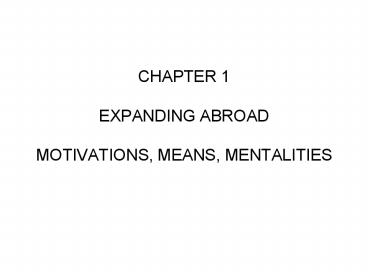CHAPTER 1 EXPANDING ABROAD MOTIVATIONS, MEANS, MENTALITIES - PowerPoint PPT Presentation
1 / 10
Title:
CHAPTER 1 EXPANDING ABROAD MOTIVATIONS, MEANS, MENTALITIES
Description:
How influential is the MNE regarding the world economy? What are the traditional and the ... Process typically builds on analysis, opportunism, and good luck ... – PowerPoint PPT presentation
Number of Views:554
Avg rating:3.0/5.0
Title: CHAPTER 1 EXPANDING ABROAD MOTIVATIONS, MEANS, MENTALITIES
1
CHAPTER 1EXPANDING ABROAD MOTIVATIONS, MEANS,
MENTALITIES
2
KEY QUESTIONS
- How is the MNE defined?
- How influential is the MNE regarding the world
economy? - What are the traditional and the more recent
motivations for firms to internationalize? - What are the prerequisites for internationalizatio
n? - What is involved in the process of
internationalization? - What are the 4 mentality models relating to the
transition from international to transnational?
3
DEFINITIONS OF THE MNE
- Generic use of the term multinational
enterprise (MNE) - ( means Dr. Ks preference or topic)
- The conceptual definition
- - Direct investment (not portfolio) in 2 or
more countries
- Integrated management
- Strategy
- Structure
- Resources
- Statistical definition of the MNE
- - USA 10 ownership of foreign shares
4
INFLUENCE OF MNEs ON WORLD ECONOMY
5
INFLUENCE OF MNEs ON WORLD ECONOMY
- 45 countries GDPgtExxonMobils VA 88ltEMs VA
(est.)
- 2/3 world trade by MNEs ½ intra-MNE, ½
external
- Influence by sector Top 500 MNEs account for
- - 85 of worlds autos
- - 70 of worlds computers
- - 65 of Worlds softdrinks
- UN estimates (2004) 70,000 MNEs, 690,000
foreign - affiliates, revenues gt 18.7 trillion
- Influence of the world economy on MNEs
- - Research unclear issue under debate
6
TRADITIONAL AND RECENT MOTIVATIONS TO
INTERNATIONALIZE
- Traditional triggers
- - To secure key supplies mining, energy,
plantations - - To secure markets Nestle, Bayer, Ford,
Heinz - - Motivations evidenced in Vernons Intl PLC
Theory
- More recent motivations
- - Securing and implementing competitive
advantages
- Scale and scope economies production, RD
- Using comparative advantage for competitive
advantage
- Using competitive positioning -
Cross-subsidization of markets - Threat of
retaliation
7
PREREQUISITES FOR INTERNATIONALIZATION
- The liability of foreignness (LOF)
- Definition
- Need to overcome the LOF to benefit from market
- How to overcome the LOF?
- - Implement competitive advantages
- Scale/scope economies, technology, brands, etc.
-
- Possess or develop internalization advantages
- Summary
- Potential for location-specific benefits for
the MNE
- MNE has owner-specific advantages to overcome
LOF
- MNEs benefits from internal competencies gt
benefits - from (external) contractual relationships
8
PROCESS OF INTERNATIONALIZATION
- Process typically builds on analysis,
opportunism, - and good luck
- The Uppsala school options approach
- - A knowledge-accumulation, risk-reduction model
- - Explains much but not all
- - Scope economies at work
- - Other forces may be at work
- Forces such as control, timing, resources, and
competition (see next slide)
9
PROCESS OF INTERNATIONALIZATION(follow-up)
10
THE 4 MODELS INTERNATIONAL TO TRANSNATIONAL
- International mentality
- - Ethnocentricity
- - Derived from Int/l PLC model directly
- - Affiliates are foreign appendages
- Multinational mentality
- - Polycentricity
- - Whole is the sum of the parts
- Global mentality
- Product standardization across markets -
Centralized RD, manufacturing, strategic
decisions
-
- Transnational Mentality
- - Capture benefits of global efficiency
- - Respond to local needs































